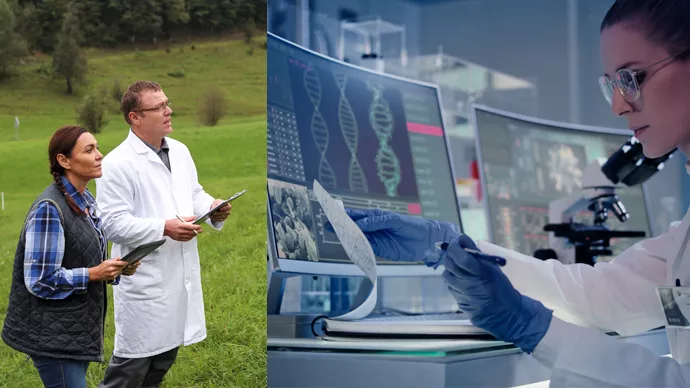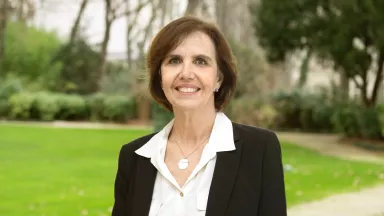
Reinforcing WOAH support for veterinary services based on digital and genetic technologies
Partager la page
The development of digital tools enables very significant progress in the production, sharing and exploitation of data on pathogens and vectors. In addition to that progress, especially in the field of genetics, generating precise sanitary data of great importance for veterinary services, digital technology has revolutionised our ways of communicating and enables us to be more effective together at regional or local levels in managing expertise and inspections.
Facilitation of disease detection, prevention and control using effective tools and shared skills
Thanks to WOAH coordination, the veterinary services could in the future benefit from new resources to improve the efficiency of the detection, surveillance and control of diseases with:
- More precise characterisation of pathogens at shared cost:
A genetic sequencer is very expensive. Every country should be able to avail itself of the genetic sequencing of pathogens thanks to the sharing of resources based in WOAH reference laboratories and with joint finance from funds for modernisation and resource pooling. Sequencing enables differentiation of the strains circulating in a region and determination of their capacity to cross the species barrier.
- Shared surveillance data, including photos of lesions, identifications of pathogen strains and serovars and information on their resistance to treatment aimed at surveillance as close as possible to the field level:
Livestock farmers, veterinarians and sentinel communities can contribute to surveillance using straightforward digital tools such as a mobile telephone with installed software, similarly to telemedicine and teleexpertise. The emission of signals can allow early detection and epidemiological analysis of the situation.
A digital platform for information exchange that includes symptoms and genetic data on pathogens in circulation would enable each national service to produce in real time a sanitary situation map to be shared with its veterinarians in the field – thereby encouraged to contribute – and colleagues in border veterinary services. Such information on zoonoses can be discussed in working meetings coordinated between veterinary services and human public health agencies, making WOAH members central to the building of the “One Health” concept in all countries.
The characterisation of pathogens and vectors, in combination with digital information exchange, should make it possible to strengthen the surveillance not only of antimicrobial resistance, but also of the resistance of vectors and parasites to treatment solutions, these being subjects of major concern.
Relevant supply of veterinary drugs, vaccines and reagents
With real-time monitoring of pathogen strains and their crossover to new species, the producers of vaccines, anti-infective drugs and diagnostic kits would be able to anticipate the needs of veterinary services and agricultural sector organisations for their country. This entails close interaction between the producing pharmaceutical companies and demand, something that WOAH could encourage. Production capacity in the various regions and sub-regions could then be re-examined with a view to meeting regions’ expectations regarding sanitary sovereignty.
The digitisation of veterinary services helps enhance their attractiveness
The digitisation of veterinary services must accelerate, using funding and a sharing of the digital solutions of those countries that possess them. Such digitisation should make rapid feedback of information possible in order to adapt risk analysis and resources, with access to expert knowledge. The concept of “epidemic intelligence” could be developed by WOAH members. Exercises in crisis management could be proposed jointly with the WHO.
Digitisation should also enable local and national services to share a digital certification platform on the e-Phyto model proposed for plants by IPPC and FAO. Placing such a resource at the service of greater dialogue with “One Health” actors will reinforce the geographical coverage of government services and enhance the attractiveness of the job of inspector for young veterinarians and technicians.
WOAH must continue to provide support to veterinary services everywhere in the world, using e-learning and short, repeated webinars particularly for the focal points. In the same way, reference laboratories and collaborative centres could teach the new methods of analysis or provide scientific and technical information through short and repeated webinars. The energisation, and indeed the consolidation, of the network of centres dedicated to health economics should be pursued in light of the importance of the availability of cost/benefit analyses for our animal health policies. At last, WOAH could develop a network of experts to be called upon for technical support via a help-desk.
Innovation must be at the heart of WOAH’s strategic project, and must be integral to standards. We must be vigilant collectively in ensuring that those standards do not constrain the development and deployment of innovation that serves animal health and sustainable agricultural production.
Voir aussi
Video - Emmanuelle Soubeyran: candidate for the position of Director General of the WOAH
08 avril 2024Santé / Protection des animaux

Emmanuelle Soubeyran's program
25 mars 2024International

